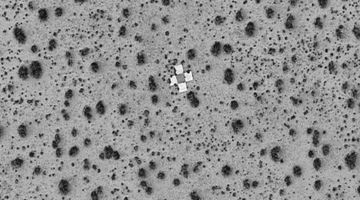Mobile machines
Interview

HeHe
Interview with Helen Evans and Heiko Hansen.
May 2023 for la mire.
You notably address mobility issues, why does this subject interest you? Why are you particularly interested in guided rail transport systems?
Our practice shifts between disciplines and we often appropriate methods from urbanists or engineering, but « artist train operator » sounds curious or even a bit odd, so we will attempt to describe what this means.
Our projects almost always begin with an idea to reinterpret an existing site, taking into account its history, usage and type of interaction it affords. In 2001, we lived close to the unused railroad La Petite Ceinture in the 19th arrondissement in Paris and were artists in residence at Mains d’Œuvres, an independent place for making and exhibitions, in Saint-Ouen. The daily commute between these two points on the edges of the capital was the beginning of the Train Project. In an instant, we imagined the entire vision: a complete train service designed and operated by artists. The work to make this idea a reality is more complicated. Ten years later, Metronome became operational, working as a performance, between the Porte de Clignancourt and the L’Avenue de Saint-Ouen. Metronome is an automated, autonomous train capsule, a two person taxi-robot, in the form of a transparent tube illuminated by an iconic yellow M. Operated by a single button in the floor of the vehicle, the passengers are in control of the ride. A series of buttons, triggered by markers fixed to the sleepers, triggers the start and end points and the direction of the journey. Lightweight and solar powered, it is designed as a temporary infrastructure, to be deployed easily and quickly. We collaborated with Les Jardins du Ruisseau, a community of gardeners that took root on the disused train platform, and their annual festivals literally unlocked access to the rail tracks. This artist-run transportation service was open to the public to use during the festival in 2012 and 2014.
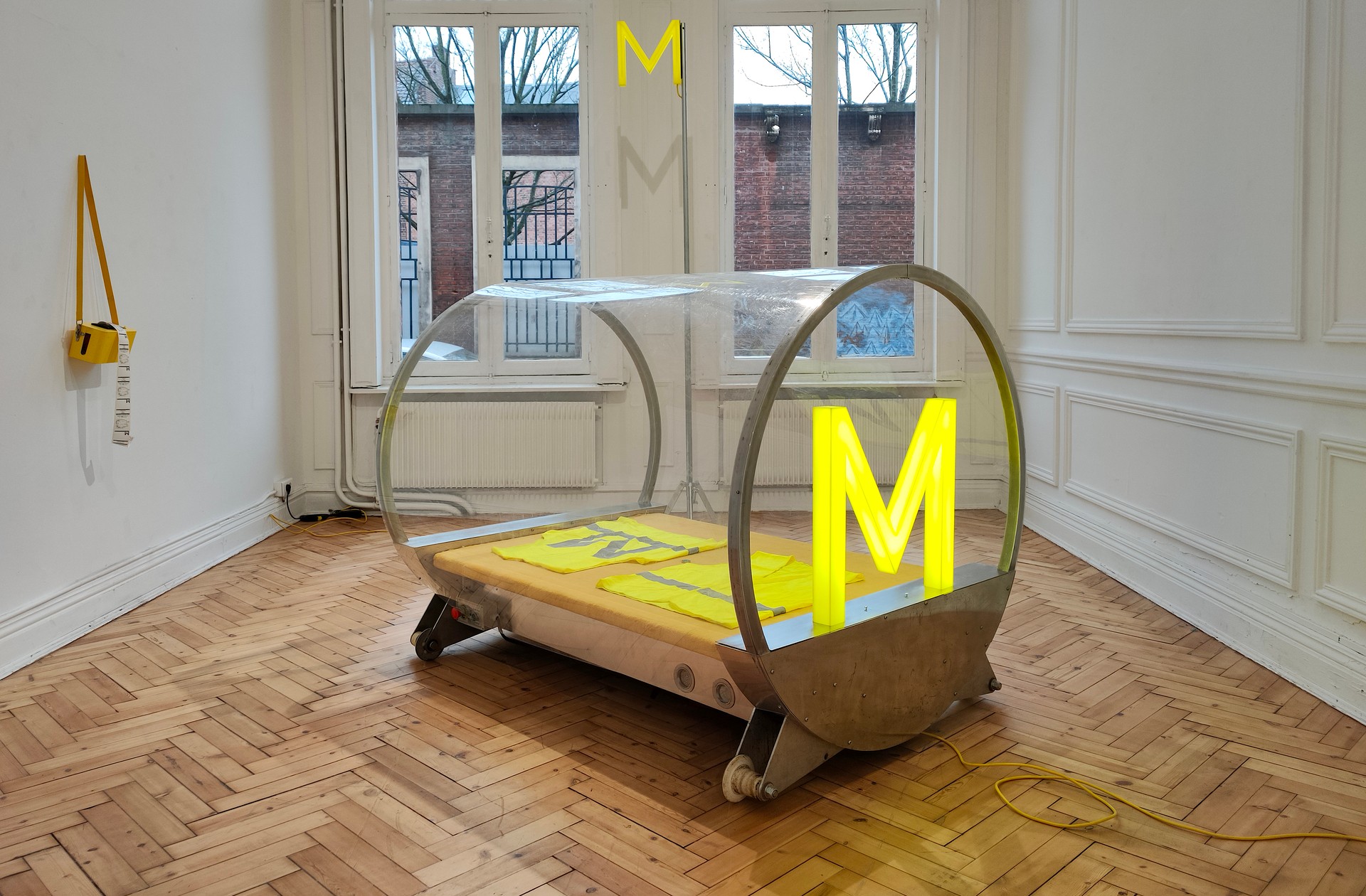
HeHe, Metronome (The Train Projekt), 2012, Exposition ORS à l’Esä - Site de Tourcoing. © HeHe.
In parallel, the Train Project grew as a work cycle in many forms, adapting to particular places and contexts. As part of this research, we wrote the Artists Rail Network Manifesto to reclaim abandoned rail tracks for artistic use. The goal of the project is to reappropriate rail infrastructure, to explore and test new aesthetics of movement, to celebrate transport that is light, modular, open-access, local, slow, flexible, electric, ad-hoc... We see rail transport as an urban theatre, to design the locomotive and the entire culture around it too, from the tickets, uniforms, communication technologies, etc. It is a call for a new aesthetics of movement on rails.
Rail and energy extraction are deeply entangled. The railway was invented to move peat and then coal from the mines to the cities. They are at the origin of modernity where the inception of industrial culture was forged by technology. It took time for railways to be considered and valued as cultural heritage. The inherent necessity of the railway to transform the landscape, to cut through hills, to bridge valleys to reach destinations, made them controversial. In the 19th century this was seen as brutalising the natural landscape. From an ecological perspective, these perfectly horizontal tracks are efficient for low energy gliding movement. The railway infrastructure could support ecological values, universal access, shared public space and be a site of unexpected encounters with strangers. At the same time, train services have become focused on inter-city, high-speed travel, where social interaction has been replaced by social media and the large seats are less economically accessible. These contradictions create a field of tension about ecology, technology and society and therefore an interesting landscape for artists to intervene in. These works speculate on alternative ways of living.
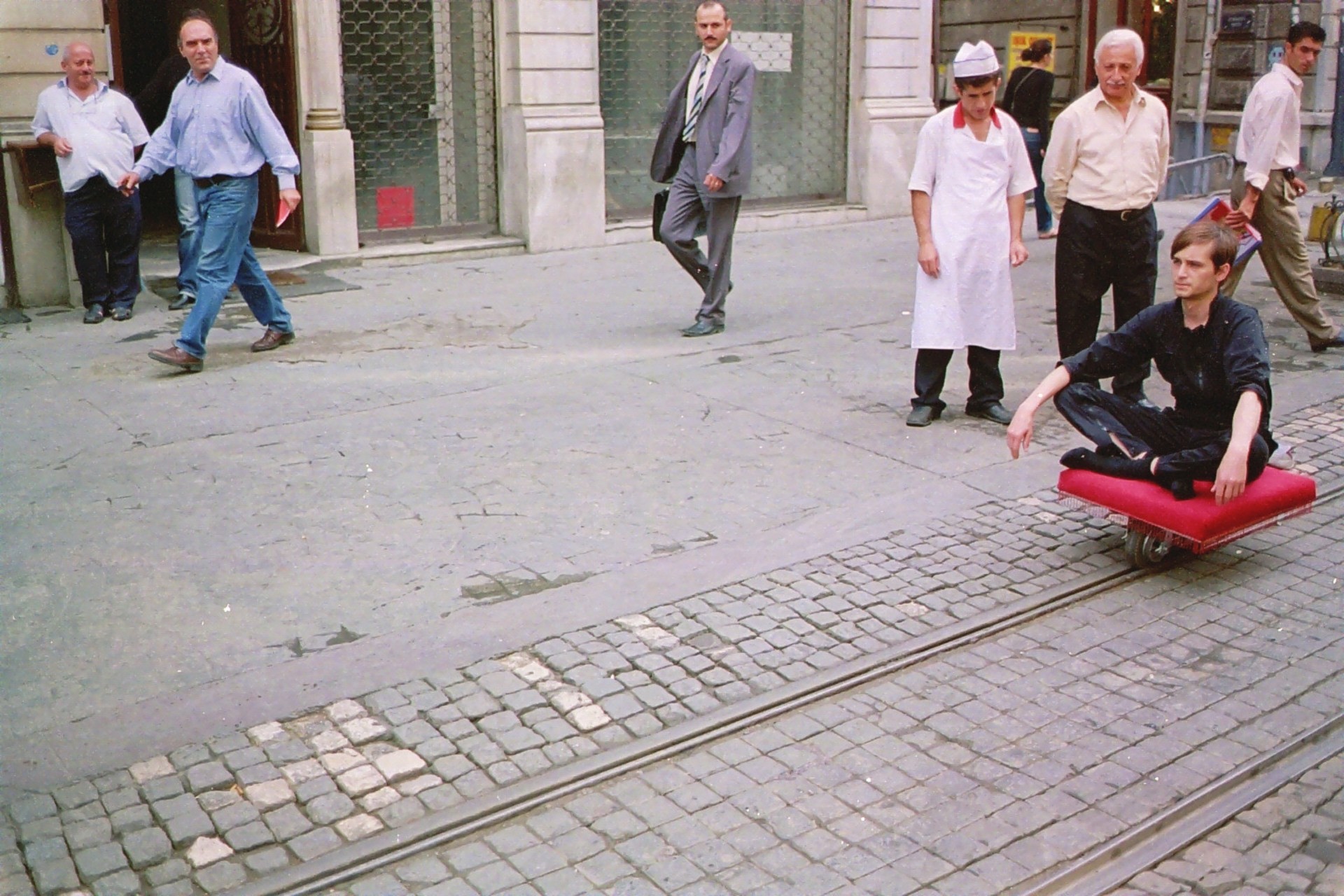
HeHe, Tapis volant, 2005, Istambul. © Ali Taptik.
How do you prepare the different sources of energy to operate the machines you invent?
Each train uses a specific energy as its source of propulsion. It is the environment that determines the form of the vehicle and its mechanical propulsion.
For example Tapis Volant, was made for the event Vehicles of Registration and Omniscient Observational Mechanics, during the 2005 Istanbul Biennial. There is a mesmeric connection between the form of the carpeted vehicle, the site of the Istiklal Avenue and the mode of operation – they work together to create a moment of performance. The vehicle, which runs on a small electric motor, can only be operated in the cross-legged, padmasana or lotus position. This body posture is from traditional eastern meditation and suggests a calm, mindful, form of mobility. The experience of driving Tapis Volant is automated: The vehicle glides along the tracks, accelerated by the act of tilting forward and comes to a standstill when leaning back. This method of operation shifts the ratio between automation and control: allowing for an unconscious, embodied modus operandi.
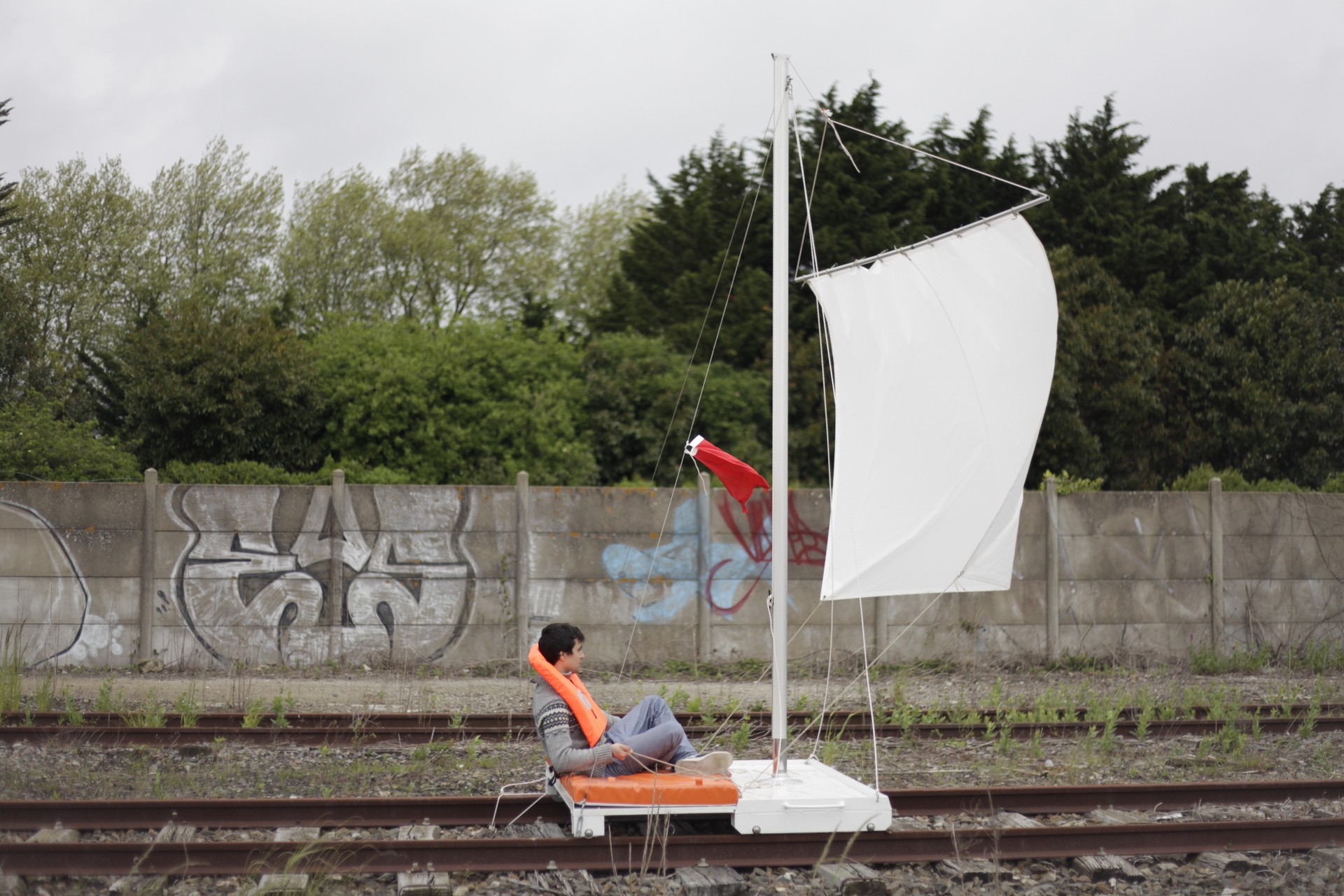
HeHe, Radeau de sauvetage, 2013, Lorient. © HeHe.
Radeau de Sauvetage was made during an artist residency, Géographies Variables, EESAB – site de Lorient, in 2013. The Radeau de sauvetage was a direct response to the potential of the site – the wind, the unused rail track, the proximity to the fishing port and of course the urgency of climate change. The origin of the project was a small documentary photograph of a vélo-voile which we saw in the exhibition Contre vents et marées at Le Lieu in Lorient. We constructed a wind-powered draisine with local artisans, not knowing if the wind would be able to propel the vehicle with such a small sail.
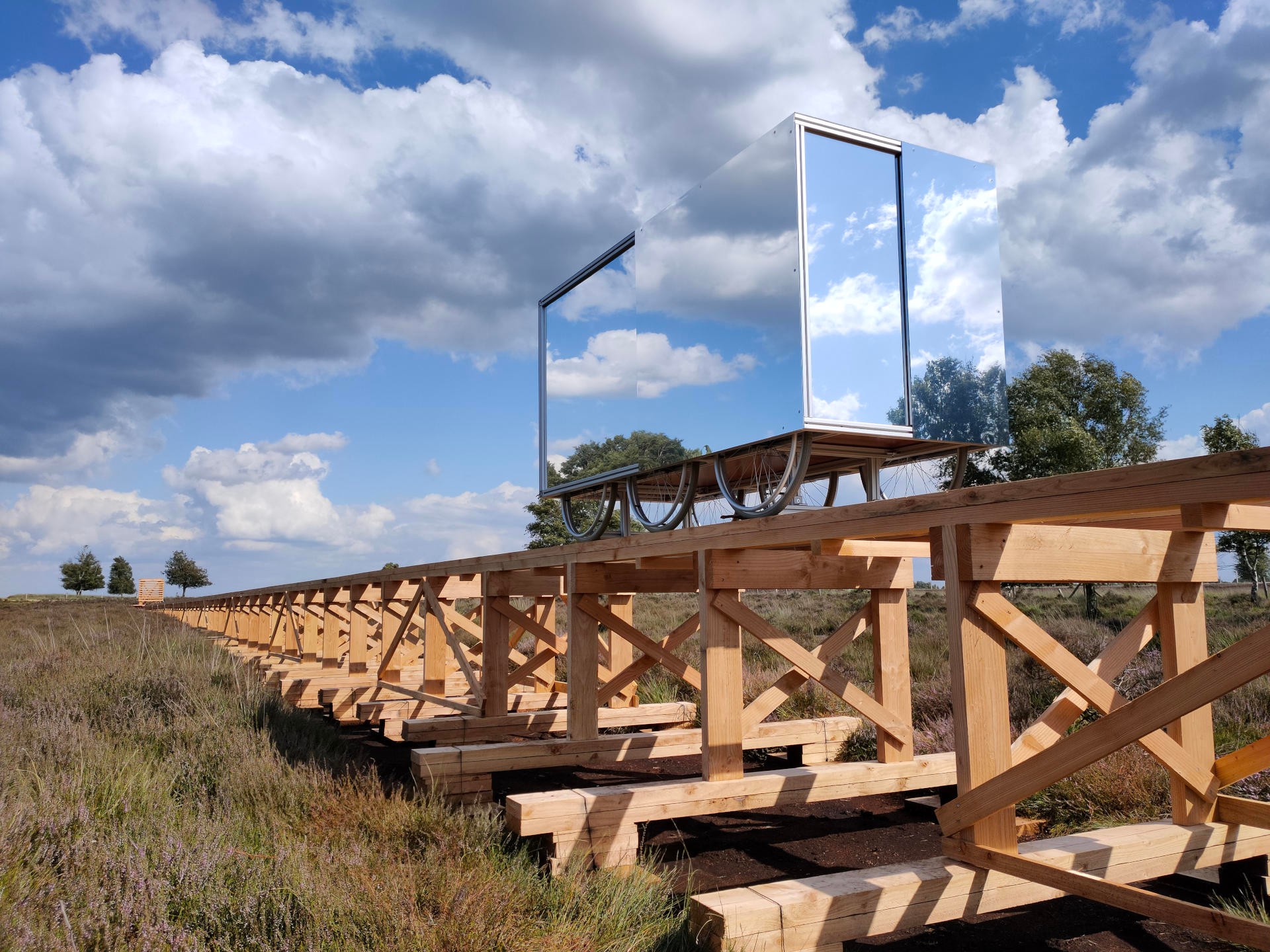
HeHe, Slow Train, 2021, Drenthe, Netherlands. © HeHe.
The Slow Train was in operation for one summer as part of the biennial Into Nature (Drenthe, Netherlands, 2021). Designed with wheelchair wheels, the vehicle moves with bicep-power. The vehicle was inspired by old railways that once served the peat industry in a wild landscape that has now become a vast nature reserve, home to rare birds and wildlife. The vehicle rolled along a horizontal rail structure, made of pine, that gradually elevated as the landscape sloped downwards. The vehicle blends in with its environment, reflecting the sky and earth on its mirrored surfaces. The travellers do not disturb the surrounding nature as the vehicle moves by stealth, slowly and silently.
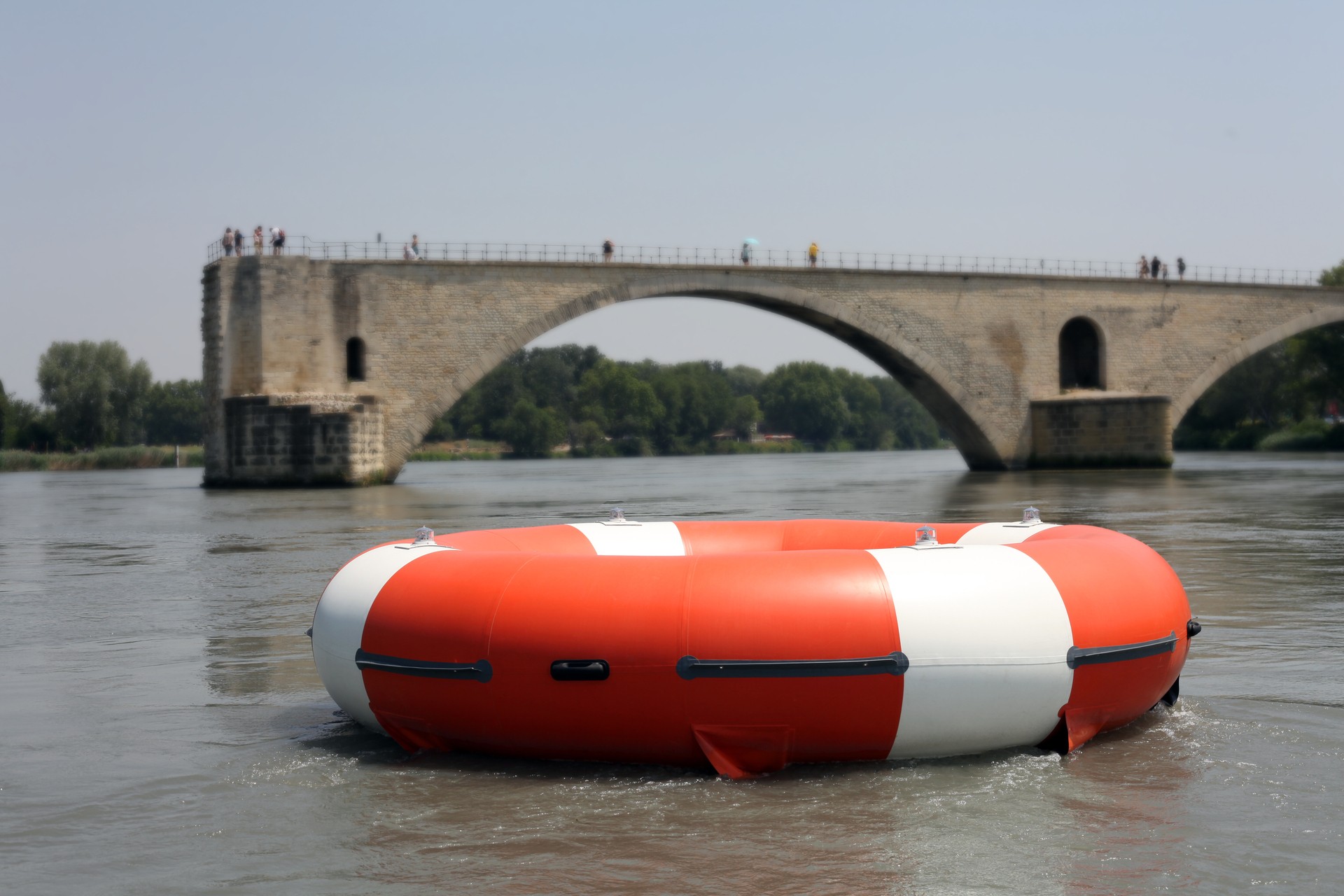
HeHe, Orbital Station River, 2019, Avignon. © HeHe.
Orbital River Station, a floating inflatable sculpture, turns by harnessing the energy of the river current. Making this rotational movement purely through the form of the sculpture required many models and tests. We collaborated with a fluid dynamics science laboratory to test different forms and a marine engineering company to fabricate the final sculpture.
All our projects start from an iconic form of transportation which is connected to the local context (a flying carpet, the M of the Metro, a sail, a cloak of invisibility, a life ring, a metro chair, a lone wheel). For each project we seek to « invent » a new drive, a new form of movement. The mechanics of the object follow on from the cultural icon. We defined this work method as « reverse cultural engineering ». Rather than a technological invention creating a culture, we look at the local culture, its uses, the geography of the site, the historical context, etc. and use this « cultural study » to invent a new form of mobility.

HeHe, M-Blem (The Train Projekt), 2012, Manchester. © HeHe.
During their two conferences at esä, Heiko spoke about the book Aramis or the love of techniques. Can you reveal what the work of Bruno Latour brings to your own research?
In Aramis or the love of techniques, Bruno Latour uses the format of the detective story to understand the failure of Aramis – Aramis (an acronyme for Agencement en Rames Automatisées de Modules Indépendants en Stations) was a RATP/ Matra Transport research project from 1970— 1987 that attempted to build a Personal Rapid Transit (PRT) system for Paris. It was intended to be a modular light-weight, autonomous mini-metro, entirely automated, using the latest advances in electronic communication systems. At its core, The Train Project is like Aramis, a research project about the complete system: the infrastructure with all its objects, interactions, forms and mental projections. It is as if our small art collective HeHe could emulate a research organisation or a public utility like the RATP (Régie Autonome des Transports Parisiens) or SNCF (Société Nationale des Chemins de Fer). Paradoxically, this model makes our own project more humble and brings humour and lightness to our inventions. It also makes our project impossible to complete and that is essential. Aramis had the same problem: it is vanity to invent an infrastructure from scratch. Technological infrastructures grow over time and are situated within social relations. Bruno Latour untangled a complex system at the beginning of its conception. At times, Aramis was a sourcebook for The Train Project. We have been inspired by single phrases, for example « the programmed metro chair » and made them into objects (H-line, 2007). Latour’s factual and humorous account of technical details – such as « non-mechanical coupling » – have been revisited and interpreted in Metronome (2002-2014). Coincidentally, Aramis was tested on a section of La Petite Ceinture, just like Metronome.
Another influence is Wolfgang Schivelbusch and in particular his book Histoire des voyages en train. Schivelbusch, was a cultural historian who shines a light on the connections between the history of mentalities, technology and knowledge. He unwraps the way in which the railway developed as a « machine ensemble » and transformed people’s way of seeing the world. He looks at the material reality of early railways, the vibration, the fatigue, the trauma and describes how the invention of the railway journey brought about a shift in mental perception. The first train passengers found the railway experience alienating compared with organic forms of mobility, powered by horses and wind, which had a direct relationship with the terrain that they traversed. This helped us to imagine the experience of movement in our performance-sculptures: to consider the motion, performance, body posture, speed, perspective, views of the foreground and background.
Are you sensitive to the ecological impact of human activities? Do you consider that artists have an environmental responsibility to uphold? If so, how?
The environmental crisis is an urgent contemporary issue, everyone has played a part and we are all responsible. Art has the power to invent original ways of seeing and perceiving this crisis. It is remarkable and true, once an image is made, the knowledge or meaning it conveys can become obvious, an evidence, to all. Such is the power of the image. With sculpture, form and material, art can invent ways to adapt to this crisis rather than just simply understanding it. The artistic possibilities for exploring « how to live », through images and forms, are vast.

HeHe, Fleur de Lys, 2009, Photographie Marc Paeps. © HeHe.
In our work, energy, its production, its consumption and its transmission is a recurrent subject. This can manifest as a provocation for example Undercurrent (2012) or sometimes, with derisive humour, for example Toy Emissions (My Friends all drive Porsches…) (2007) or Prise en Charge (2012). Other works are more mysterious, immersive experiences, such as Fleur de Lys (2009) and Réchauffement Domestique (2014) or visceral, haptic performances such as Fracking Futures (2013). In Nuage Vert (2001 – 2010), we projected a green laser beam onto the contour of a power plant emission. An essential part of the project was the mediation between the artwork and the diverse publics, to activate people through public debate. The artwork makes a visual link between energy production, to consumption and invites people to consume less energy to make the green cloud bigger. It is art-activism.
All our projects are environmental. They begin with images, usually contradictory ones. Often the images we choose are quite direct, offering deadpan humour, comical illustrations of our environment, place holders for paranoia, ecological breakdown or remorse about our industrial world. We seek to create the absurd, mixing playfulness and seriousness, amplifying the existing, making the visible more visible. Such images offer no redemption, no healing or therapy, perhaps irony is a mischievous alternative to the present. What infrastructure will become heritage in the future? nuclear power plants, waste incinerators, high speed trains, electricity pylons, air pollution measuring grids, fracking wells ? It is this dark side that underpins our culture that holds an imaginative power to think about ecology.
You are artists and also teachers at EsadHar, the Havre-Rouen art school (Le Havre campus). Do these questions relating to energy and mobility also enter into your educational activities? If yes, how?
At EsadHar, in Le Havre, we coordinate a Masters in Fine Art diploma (DNSEP) called Art Media Environment. We encourage students to think about the question of environment in their work, as a subject, but mostly as a base to create art outside of a gallery context. Students are asked to respond to the constraints of a particular site or situation, and adapt to that context. We set up collaborations with outside partners so that students work in real world situations and expose their work to the public. Fostering group work and collaboration is also an essential part of our teaching because working in the public realm is always collaborative. Environment is a highly social space.
With master students we are not prescriptive about the subject and media that students work with. It is essential to give students the freedom to choose new subjects and and explore different media so that they can, we hope, expand the field of artistic practice.
Publication
Man Made Clouds, Éditions Hyx, Orléans, 2017.
Artists website
Expositions Mouvements périphériques
From March 8th to April 7th, 2023
O.R.S (Orbital River Station)
Galerie de l’Exutoire
Esä | site de Dunkerque
Radeau de sauvetage (The Train Project)
Galerie des Ursulines
Esä | site de Tourcoing

